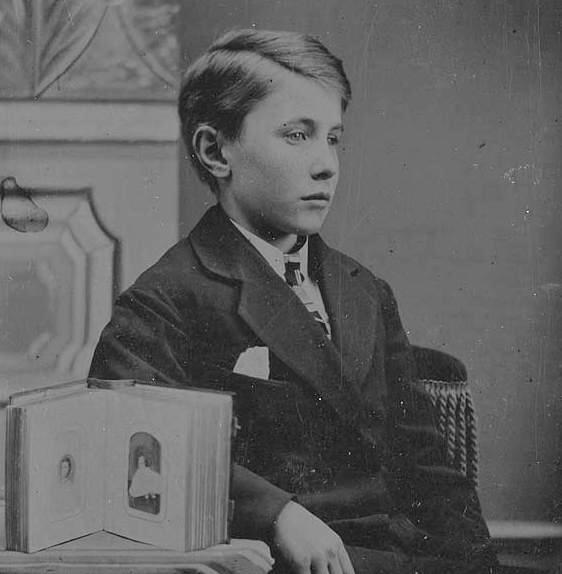
Family Photographic Albums

Figure 1.--This American tintype portrait shows a boy With a family photo album. The portrait is undated, but we would guess was taken in the 1870s. Most of the time when these album are on the side stand, they are closed, in this case it is open showing more photographs. This looks to be a CDV album, but it probably could accomodate tintypes as well. It looks like mother may have opened up a baby portrait of the boy.
|
|
The family photograph album, in propsperous families several albums, was one of the most prized possessions of any Victorian family by the 1860s. As such surviving albumns are wonderful historical documents. The multiple images provide important details about how one or related families dealt with clothing styles, age appropriate clothing, cultural trends such as breeching, and hair styling. Affluent families might have albums with beauttifully tooled leather covers. Some might even have artistic script inside. Often there were metal claps to keep the allbum closed. Some even locked with a key. I'm not sure why that was seen as necessary. Less affluent families of course would have much more modest albums.
Chronology
The earliest photographic albums probably date to the early 1860s with the development of CDVs. Early portraits such as Daguerreotype were kept in individual cases. Tin
types were difficult to save in albums.
Prized Possession
The family photograph album, in propsperous families several albums, was one of the most prized possessions of any Victorian family by the 1860s. The family album or allbums were normally kept in the family parlor and brought our when family and friends visited.
The parlor was often at the center of the 19th century home. Families varied on how the palor was used. Some used it for company and the children often did not have free access to it. In other families it was used more of a family room. In such cases the children were more welcome--but on their best behavior.
The Victorian and Edwardian parlor was changed for ever by modern technology. First it was the phinograph at the turn of the 20th century. Then in the 1920s with the development of the radio and after World War II the development of television. The parlor has become the living room in the modern home. Some of the activity formerly conducted in the porlor has moved to the actibity room in the modern American home.
Interesting features of many Victorian parlors were screens where "scraps" (cutouts), greening cards, and postcards might be used
to decorate. The Victorians, both children and mothers also loved to keep scrapbooks in their parlors. A variety of items might be included in these scrapbooks, including photographs, "scraps", lettters, postcards, clippings. pressed flowers, and much more.
Almost all of the albums we have noted in old photographs are book-type albums. The most popular types was stiff carboard pages with slots in which CDVs or cabinent cards could be inserted for easy viewing. We also note a rotating stand which was used to disply portraits. There appear to be transparent sleeves in which the portraits could be inserted. With these rotating stands, guests could flip through the family portraits. The rotating stands do not seem to be nearly as common. As least we see very few examples in the photographic record. We are not sure just when they first appeared. We are not sure just when these rotating stands first appeared. We see them at least by about 1890.
Historical Documents
As such surviving albumns are wonderful historical documents. The multiple images provide important details about how one or related families dealt with clothing styles, age appropriate clothing, cultural trends such as breeching, and hair styling. A HBC reader writes, "It's a shame when albums are broken up and the photos sold separately, if I
had not bought the Capper album complete, for example, it too might have been broken up. Incidentally, the loose photos next to the album in the photo I sent were purchased at the same fair but from a different dealer than the one who sold me the actual album. It was only when I arrived home and looked at at the album more closely that I saw the connection."
Albums appeared almost as soon as CDV portraits became popular. Daguerreotypes and ambrotyoes were not appropiate for albums. Portraits printed on paper-mounted cards were, however, just right. Affluent families might have albums with beaitifully tooled leather covers. Some might even have artistic in the early 1860s. script inside. Often there were metal claps to keep the allbum closed. Some even locked with a key. I'm not sure why that was seen as necessary. Less afflurnt families of course would have much more modest albums. The albums in the 19th century were made to hold specific types of portraits, including CDVs and cabinent cards. Tintypes were also kept in the albums, but this was a little more complicated as they were ot astandard size like CDVs. The albums had slots into which the portraits were inserted. European albums were often for CDVs as that format was so popular there. Some albums had one image pages while others had slots for four images.
HBC has several family collections from different countries. Most are albums submitted by HBC readers, both of their own families and by collectors of old photographs. A few are family images compiled by separate purchases of old photographs over time. We are collecting an increasing number of these images which provide a fascinating view of late 19th and early 20th century families.
HBC

Navigate the Boys' Historical Clothing Web Site:
[Return to:Main photography page]
[Return to:Main photo/publishing page]
[Introduction]
[Activities]
[Biographies]
[Chronology]
[Clothing styles]
[Countries]
[Topics]
[Bibliographies]
[Contributions]
[FAQs]
[Glossaries]
[Images]
[Links]
[Registration]
[Tools]
[Boys' Clothing Home]
Navigate the Boys' Historical Clothing Web Site:
[Sailor suits]
[Sailor hats]
[Buster Brown suits]
[Eton suits]
[Rompers]
[Tunics]
[Smocks]
[Pinafores]
Created: April 1, 2003
Last updated: 10:22 PM 2/20/2009



